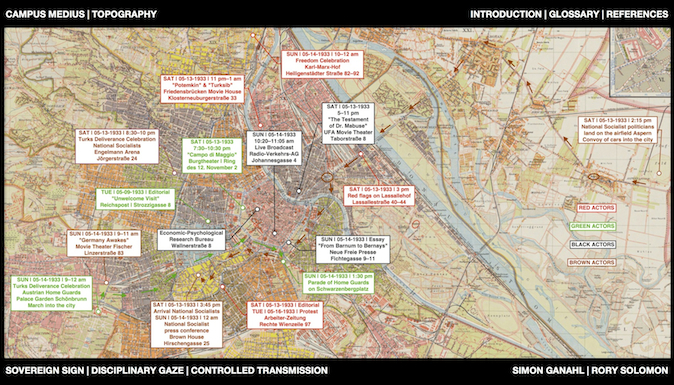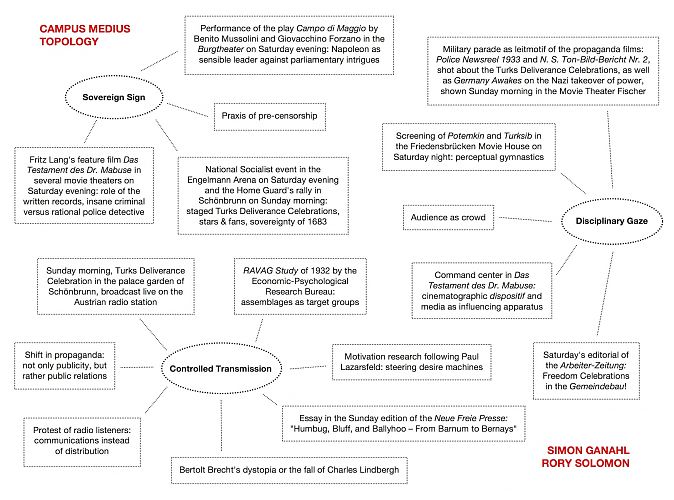Campus Medius: Project Proposal
|
Simon Ganahl
· Rory Solomon July 27, 2013  DOI: 10.13095/uzh.fsw.fb.23 DOI: 10.13095/uzh.fsw.fb.23
editorial review CC BY 4.0 |
print comment |
Keywords: actor-network | deleuze | digital humanities | dispositif | latour | mapping | media
The mapping project "Campus Medius" has recently been submitted for publication in the online journal Sensate. It is being peer-reviewed over summer, and will be produced in fall. By posting the proposal of their media-historical project on the G+C Blog, Simon Ganahl and Rory Solomon seek to receive feedback on all aspects of "Campus Medius," in particular on its theoretical background and technological implementation. The authors look forward to reading your comments and to discussing any objections or suggestions you may have.
"Campus Medius" investigates mediality as historical experience. Methodologically, the mapping project deploys a dispositif analysis following Michel Foucault, directed at identifying the conditions under which the experiential field of modern media was able to emerge. This concept addresses three levels, distinct in terms of their perspective but empirically overlapping: an archaeology of knowledge forms, a genealogy of power relations, and a typology of subjectivation modes. As an exemplary case, "Campus Medius" focuses on a chronotope (Bachtin 2008 & Schlögel 2008) of twenty-four hours between May 13 and 14, 1933, in Vienna, which is marked by the Türkenbefreiungsfeiern (Ackerl 1984) held by the Austrian National Socialists and the Home Guards. These events, celebrating the 250th anniversary of Vienna's liberation from the Turkish siege in 1683, were oriented from the outset upon processes of mass communication: the rallies were prepared by the party-political press, partially broadcast live on radio, and captured in propaganda films. To create a counter-public sphere, the Social Democrats published programmatic editorials and organized open-air concerts in the municipal tenements of Vienna. While the Burgtheater presented Benito Mussolini's play Campo di Maggio, the large cinemas were screening Fritz Lang's sound movie Das Testament des Dr. Mabuse, a film banned in Germany. "Campus Medius" reconstructs the media events of this time-space and traces them back to historical media dispositifs. Hence, the project consists of two integral parts:
1. Topography: an interactive map of the chronotope, including hypermedia documents such as video clips, newspaper articles, radio broadcasts, photographs, and archive files. For now, the events are arranged politically—red for socialist and communist actors, green for Austrofascist actors, brown for National Socialist actors, and black for bourgeois actors.
2. Topology: an argumentative analysis of the chronotope's knowledge forms, power relations, and subjectivation modes. Based on the concrete events, this part of "Campus Medius" examines functions of media in the classical, modern, and postmodern age—a periodization which constitutes the organizational structure as represented in the diagram.
Regarding the technological architecture, we want to use two platforms: the Urban Research Tool (URT) to show the topography—an interactive map—and Zeega to tell the topology—an argumentative analysis. These platforms provide two complementary lenses for exploring the collection of media material, and will be accessible through one interface: a website with the URL http://campusmedius.net. On its front page, an image of Vienna's historical map will be integrated with URT as a kind of basemap, rectified to align with the underlying OpenStreetMap data. The user can either wander through the actor-networks by clicking on the hypertextual points and paths, or follow the Zeega tours that offer three narrative montages, thereby allowing cross-references between the platforms. While the mapped topography describes the events and displays the related media in a networked structure, the Zeegas—titled Sovereign Sign, Disciplinary Gaze, and Controlled Transmission—attempt to explain the historical frames of the actual experiences, corresponding to the periodization mentioned above. Apart from access to these tours, the interactive map as interface should additionally provide links to three subordinate pages: firstly, a text that introduces the project to the users; secondly, a glossary of the main theoretical, topical, and technological terms; thirdly, a list of references and sources.

The Türkenbefreiungsfeiern connect the chronotope with the siege of Vienna in 1683 or—in a broader view—with the classical age. In Foucault's philosophy, this historical dispositif features representation as knowledge form, sovereignty as power relation, and God as subjectivation mode. (Foucault 1966, 1975 & 1976) As shown in the overview of the project's topology, the Viennese weekend actualizes not only these classical attributes, but also some features of the modern dispositif in Foucault distinguished by man as knowledge form, disciplinarity as power relation, and individuals in masses as mode of subjectivation. (Foucault 1966, 1975 & 1976) Finally, the exemplary time-space also gives examples of a postmodern dispositif with communication as knowledge form, control as power relation, and assemblages as subjectivation mode. (Deleuze 1990, Hardt/Negri 2000 & Galloway/Thacker 2007) "Campus Medius" analyzes functions of media in these historical settings as well as effects of their actualization: sovereign leaders of the 17th and 18th century return as theatrical stars; movie houses resemble disciplinary institutions of the 19th century; controls of communication processes as established in the 20th century appear in the form of target groups and public relations; etc.
The research project deals with theoretical, empirical, and representational problems currently under discussion in cultural studies and humanities:
- As for methodology, "Campus Medius" contributes to the clarification of the relationship between actor-network theory (Latour 2005) and dispositif analysis (Foucault 1977). According to our thesis, the former suits the description of concrete events that involve humans and things while the latter allows us to derive the examined cases from historical knowledge forms, power relations, and subjectivation modes. (Ganahl 2013) This separation is implemented in the dual structure of topography and topology. Due to the media historical subject, the project not only takes up the philosophical (Deleuze 1989 & Agamben 2009) and sociological (Law 1992 & Bührmann/Schneider 2008) discussion, but also the so-called apparatus debate (Baudry 1975 & Rosen 1986).
- Concerning its topic, "Campus Medius" relates actors that are usually covered in separate fields of study. Thus, the representative architecture of Schönbrunn Palace and the disciplinary character of Karl-Marx-Hof meet each other as scenes of antagonistic rallies. (Blau 1999) The sensible leader who Mussolini imagined as Napoleon in Campo di Maggio (Dietrich 1976 & Pyrah 2007) confronts the insane criminal as depicted in Lang's Das Testament des Dr. Mabuse (Jacques 1994 & Aurich 2001). While the chancellor's speech at the Türkenbefreiungsfeier was broadcast live on radio, the bourgeois newspaper Neue Freie Presse ran an essay about Edward Bernays, a nephew of Sigmund Freud, who carried out propaganda as an "exact science" in order to direct public opinion via "group leaders." (Rundt 1933) Bernays had opened his New York office for public relations in the 1920s (Ewen 1996 & Tye 1998), but his concept to build lifestyles around products didn't fully thrive until Paul Lazarsfeld developed complementary statistical methods with his Economic-Psychological Research Bureau in Vienna. (Samuel 2010) The sociologist carried out a survey for Austrian radio in 1932 that broke with an understanding of the audience as a mass of individuals. (Mark 1996) By correlating the listeners' program wishes with their social data, he created target groups that could be exploited in commercial terms.
- With regard to dissemination, "Campus Medius" is rooted in digital humanities. (McPherson 2009 & Gold 2012) In its clear division between topographical presentation (Presner 2010) and topological analysis (Deleuze 1986), the project utilizes two distinct platforms in order to harness each one's particular affordances. While the interactive map shows the actors through hypermedia documents, the Zeega tours focus on the emergence conditions of the events. The capacity of the narrative montage to provide an argumentative explanation of its subject is juxtaposed with the chronotope's encouragement to explore the movie clips, newspaper articles, radio broadcasts, photographs, and archive files in various ways. This implementation sets a high value on technological and scholarly transparency: "Campus Medius" will be programmed with open-source software, examined in a peer-review process, and published on an open-access basis.
The weekend in Vienna on May 13 and 14, 1933, forms a point of culmination at which contrary processes converge. The events played out against the background of a media diversity that had arisen after World War I and that seemed to Austria's governing forces to be the cause of the state's crisis. As a result, the adjournment of parliament in early March 1933 was immediately followed by steps to restrict freedom of expression. These measures had not yet gathered much strength when the Türkenbefreiungsfeiern were held, so that a very complex situation arose whereby the attempt to control public communication dissipated in the multiplicity of media voices. In the chronotope we have outlined, fascist characters stepped, so to speak, onto a democratic stage that may have creaked and cracked, but did not collapse until after the performance.
Ackerl, Isabella: "Die Türkenbefreiungsfeiern des Jahres 1933. Historische Jubiläen als politische Propagandavehikel." In: Geschichte und Gegenwart. No. 1/1984, pp. 18–26.
Agamben, Giorgio: What is an apparatus? And Other Essays. Stanford 2009.
Aurich, Rolf et al. (eds.): Fritz Lang. Leben und Werk. Bilder und Dokumente. Berlin 2001.
Bachtin, Michail M.: Chronotopos. Trans. by Michael Dewey. Frankfurt a. M. 2008.
Baudry, Jean-Louis: "Le dispositif: approches métapsychologiques de l'impression de réalité." In: Communications. No. 23/1975, pp. 56–72.
Blau, Eve: The Architecture of Red Vienna. 1919–1934. Cambridge 1999.
Bührmann, Andrea D. and Werner Schneider: Vom Diskurs zum Dispositiv. Eine Einführung in die Dispositivanalyse. Bielefeld 2008.
Deleuze, Gilles: Foucault. Paris 1986.
Deleuze, Gilles: "Post-scriptum sur les sociétés de contrôle." In: Gilles Deleuze: Pourparlers. Paris 1990, pp. 240–247.
Deleuze, Gilles: "Qu'est-ce qu'un dispositif?" In: Michel Foucault philosophe. Recontre internationale Paris 9, 10, 11 janvier 1988. Paris 1989, pp. 185–195.
Dietrich, Margret: "Burgtheaterpublikum und Öffentlichkeit in der Ersten Republik." In: Margret Dietrich (ed.): Das Burgtheater und sein Publikum. Vienna 1976, pp. 479–707.
Ewen, Stuart: PR! A Social History of Spin. New York 1996.
Foucault, Michel: La Volonté de savoir. Paris 1976 (= Histoire de la sexualité, vol. 1).
Foucault, Michel: "Le jeu de Michel Foucault." [1977] In: Michel Foucault: Dits et écrits. Vol. III: 1976–1979. Ed. by Daniel Defert and François Ewald. Paris 1994, pp. 298–329.
Foucault, Michel: Les Mots et les choses. Paris 1966.
Foucault, Michel: Surveiller et punir. Naissance de la prison. Paris 1975.
Galloway, Alexander R. and Eugene Thacker: The Exploit. A Theory of Networks. Minneapolis 2007.
Ganahl, Simon: "Ist Foucaults 'dispositif' ein Akteur-Netzwerk?" [01.04.2013] In: foucaultblog. URL: http://www.fsw.uzh.ch/foucaultblog/archive/9/ist-foucaults-dispositif-ein-akteur-netzwerk
Gold, Matthew K. (ed.): Debates in the Digital Humanities. Minneapolis 2012.
Hardt, Michael and Toni Negri: Empire. Cambridge 2000.
Jacques, Norbert: Das Testament des Dr. Mabuse. Hamburg 1994.
Latour, Bruno: Reassembling the Social. An Introduction to Actor-Network-Theory. New York 2005.
Law, John: "Notes on the Theory of the Actor-Network: Ordering, Strategy and Heterogeneity." In: Systems Practice. No. 4/1992 (vol. 5), pp. 379–393.
Mark, Desmond (ed.): Paul Lazarsfelds Wiener RAVAG-Studie 1932. Der Beginn der modernen Rundfunkforschung. Vienna 1996.
McPherson, Tara: "Media Studies and the Digital Humanities." In: Cinema Journal. No. 2/2009 (vol. 48), pp. 119–123.
Presner, Todd: "HyperCities: A Case Study for the Future of Scholarly Publishing." In: Jerome McGann (ed.): Online Humanities Scholarship: The Shape of Things to Come. Texas 2010, pp. 143–154.
Pyrah, Robert: The Burgtheater and Austrian Identity. Theater and Cultural Politics in Vienna, 1918–38. London 2007.
Rosen, Philip (ed.): Narrative, Apparatus, Ideology. A Film Theory Reader. New York 1986.
Rundt, Arthur: "Humbug, Bluff und Ballyhoo. Von Barnum bis Bernays." In: Neue Freie Presse (Vienna), May 14, 1933, pp. 25f.
Samuel, Lawrence R.: Freud on Madison Avenue. Motivation Research and Subliminal Advertising in America. Philadelphia 2010.
Schlögel, Karl: Terror und Traum. Moskau 1937. Munich 2008.
Tye, Larry: The Father of Spin. Edward L. Bernays and the Birth of Public Relations. New York 1998.




